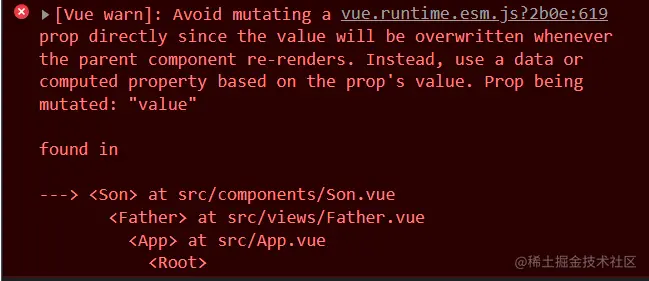 Web Front-end
Web Front-end
 Vue.js
Vue.js
 What is the difference between modifier v-model and .sync? A brief analysis of differences and comparisons
What is the difference between modifier v-model and .sync? A brief analysis of differences and comparisons
What is the difference between modifier v-model and .sync? A brief analysis of differences and comparisons
Jul 11, 2022 pm 08:37 PMWhat is the difference between modifier v-model and .sync? The following article will talk about the differences between v-model and .sync modifier. I hope it will be helpful to you!

In the daily development process, the v-model command is often used. Generally speaking, v-model Directives create two-way data binding on forms and elements, but v-model is essentially syntactic sugar. When it comes to syntax sugar, we have to mention another two-way binding syntax sugar that has similar functions to v-model, that is.sync modifier. Here is a summary of the two:
1. v-model
1. Function
I believe that friends who have used the vue framework will not be unfamiliar with this command. v-model is used to perform <input>, <textarea> </textarea>, <select></select> Two-way binding of data on elements. (Learning video sharing: vue video tutorial)
For example:
<template>
<div >
<input v-model="value" type="text"/> //這里的v-model里面的value可以直接獲取到用戶的輸入值
</div>
</template>
<script>
export default {
components: {},
data() {
return {
value:"", //這里定義的value變量可以直接將上面獲取到的值進行操作
};
},
}
</script>
<style scoped>
</style>When we enter a certain value in the input box, the value in the data below is You can directly get the value we entered without having to operate the dom element to obtain it.
1. Essence
v-model is essentially a syntactic sugar. Our habitual writing method is like this:
<input v-model="value" type="text"/>
But actually the complete writing method is like this:
<input :value="value" @input="value=$event.target.value" type="text" />
By comparing the syntactic sugar and the original writing method, we can get:
When adding the v-model attribute to the <input/> element, the value will be used as the attribute of the element by default, and the input event will be used as the trigger event for real-time delivery of value.
Note: Not all elements that can perform two-way data binding are input events!
3. Special usage
Generally, we use v-model mainly for two-way binding of data. It is very convenient to obtain the value entered by the user, but in some special cases, we can also use v-model for two-way binding of data between parent and child components.
<template>
<div class="father">
<Son v-model="str"/>
</div>
</template>
<script>
import Son from '@/components/Son.vue'; //引入子組件
export default {
components: {Son},
data() {
return {
str:"father"
};
},
}
</script>A father component and son component are defined here, and the son component is introduced into the father component, and v-model is bound to the son component to pass the value. At this time we need to receive and use this value in the son component:
<template>
<div class="son">
我是在son組件里接收到的值:{{value}}
</div>
</template>
<script>
export default {
components: {},
props:{
value:{
type:String,
},
},
}
</script>Note: The value accepted here must be value. If you write it with another name, an error will be reported!
The parent component passes the value to the child component. The data cannot be modified directly in the child component. If you modify it directly, an error will be reported.

When When we need to modify this value, we need to pass it to the parent component for modification.
This requires defining a custom event on the child component in the parent component, through the child component $emit('custom event name','value') Method passes the value into the parent component.
But we cannot use custom events here because we use v-model to pass values, so we can only use input events to make modifications.
Use the $emit() method in the child component. Call the event in the parent component and pass the value
<template>
<div class="son">
我是在son組件里接收到的值:{{value}}
<button @click="handleClick">click</button>
</div>
</template>
<script>
export default {
components: {},
data() {
return {
str:'son'
};
},
props:{
value:{
type:String,
},
},
methods: {
handleClick(){
this.$emit('input',this.str)
}
},
}
</script>This completes the bidirectional data between the parent and child components. Binding effect
2. .sync modifier
1. Function
.sync The modifier can realize two-way binding between parent and child components, and can realize the child component to modify the value of the parent component synchronously. Compared with v-model, the sync modifier is Much simpler:
2. The essence
//正常父傳子
<Son :a="num" />
//加上sync之后的父傳子
<Son :a.sync="num" />
//它等價于
<Son :a="num" @update:a="val=>a=val" />
//相當(dāng)于多了一個事件監(jiān)聽,事件名是update:a,
//回調(diào)函數(shù)中,會把接收到的值賦值給屬性綁定的數(shù)據(jù)項中。The value passing and receiving here are not the same as the normal parent component passing value to the child component. The only difference is that when the subcomponent returns a value, the event name called by $emit must be update:property name. If the event name is written incorrectly, no error will be reported, but there will be no error at that time. Change, this needs to be noted.
Summary
v-model and .sync: The same thing: they are both syntax sugar, and they can realize data communication in parent-child components.
Differences: Different formats, v-model="num" :num.sync="num"
v-model:@input value :num.sync:@update:num
Also, v-model can only be used once, and .sync can be used multiple times.
[Related video tutorial recommendations: vuejs entry tutorial, web front-end entry]
The above is the detailed content of What is the difference between modifier v-model and .sync? A brief analysis of differences and comparisons. For more information, please follow other related articles on the PHP Chinese website!

Hot AI Tools

Undress AI Tool
Undress images for free

Undresser.AI Undress
AI-powered app for creating realistic nude photos

AI Clothes Remover
Online AI tool for removing clothes from photos.

Clothoff.io
AI clothes remover

Video Face Swap
Swap faces in any video effortlessly with our completely free AI face swap tool!

Hot Article

Hot Tools

Notepad++7.3.1
Easy-to-use and free code editor

SublimeText3 Chinese version
Chinese version, very easy to use

Zend Studio 13.0.1
Powerful PHP integrated development environment

Dreamweaver CS6
Visual web development tools

SublimeText3 Mac version
God-level code editing software (SublimeText3)
 What is the significance of Vue's reactivity transform (experimental, then removed) and its goals?
Jun 20, 2025 am 01:01 AM
What is the significance of Vue's reactivity transform (experimental, then removed) and its goals?
Jun 20, 2025 am 01:01 AM
ReactivitytransforminVue3aimedtosimplifyhandlingreactivedatabyautomaticallytrackingandmanagingreactivitywithoutrequiringmanualref()or.valueusage.Itsoughttoreduceboilerplateandimprovecodereadabilitybytreatingvariableslikeletandconstasautomaticallyreac
 How can internationalization (i18n) and localization (l10n) be implemented in a Vue application?
Jun 20, 2025 am 01:00 AM
How can internationalization (i18n) and localization (l10n) be implemented in a Vue application?
Jun 20, 2025 am 01:00 AM
InternationalizationandlocalizationinVueappsareprimarilyhandledusingtheVueI18nplugin.1.Installvue-i18nvianpmoryarn.2.CreatelocaleJSONfiles(e.g.,en.json,es.json)fortranslationmessages.3.Setupthei18ninstanceinmain.jswithlocaleconfigurationandmessagefil
 What is server side rendering SSR in Vue?
Jun 25, 2025 am 12:49 AM
What is server side rendering SSR in Vue?
Jun 25, 2025 am 12:49 AM
Server-siderendering(SSR)inVueimprovesperformanceandSEObygeneratingHTMLontheserver.1.TheserverrunsVueappcodeandgeneratesHTMLbasedonthecurrentroute.2.ThatHTMLissenttothebrowserimmediately.3.Vuehydratesthepage,attachingeventlistenerstomakeitinteractive
 How do I use Sublime Text with Vue.js?
Jun 26, 2025 am 12:12 AM
How do I use Sublime Text with Vue.js?
Jun 26, 2025 am 12:12 AM
ToenhanceVue.jsdevelopmentinSublimeText,installVuesyntaxhighlightingviaPackageControl,setupEmmetforfasterHTMLtemplating,integrateESLintandPrettierforlintingandformatting,configurekeysettingslikeparserandformat-on-saveoptions,andoptionallycreatecustom
 How to implement transitions and animations in Vue?
Jun 24, 2025 pm 02:17 PM
How to implement transitions and animations in Vue?
Jun 24, 2025 pm 02:17 PM
ToaddtransitionsandanimationsinVue,usebuilt-incomponentslikeand,applyCSSclasses,leveragetransitionhooksforcontrol,andoptimizeperformance.1.WrapelementswithandapplyCSStransitionclasseslikev-enter-activeforbasicfadeorslideeffects.2.Useforanimatingdynam
 How to build a component library with Vue?
Jul 10, 2025 pm 12:14 PM
How to build a component library with Vue?
Jul 10, 2025 pm 12:14 PM
Building a Vue component library requires designing the structure around the business scenario and following the complete process of development, testing and release. 1. The structural design should be classified according to functional modules, including basic components, layout components and business components; 2. Use SCSS or CSS variables to unify the theme and style; 3. Unify the naming specifications and introduce ESLint and Prettier to ensure the consistent code style; 4. Display the usage of components on the supporting document site; 5. Use Vite and other tools to package as NPM packages and configure rollupOptions; 6. Follow the semver specification to manage versions and changelogs when publishing.
 How to use PHP to develop a Q&A community platform Detailed explanation of PHP interactive community monetization model
Jul 23, 2025 pm 07:21 PM
How to use PHP to develop a Q&A community platform Detailed explanation of PHP interactive community monetization model
Jul 23, 2025 pm 07:21 PM
1. The first choice for the Laravel MySQL Vue/React combination in the PHP development question and answer community is the first choice for Laravel MySQL Vue/React combination, due to its maturity in the ecosystem and high development efficiency; 2. High performance requires dependence on cache (Redis), database optimization, CDN and asynchronous queues; 3. Security must be done with input filtering, CSRF protection, HTTPS, password encryption and permission control; 4. Money optional advertising, member subscription, rewards, commissions, knowledge payment and other models, the core is to match community tone and user needs.
 How is Vue's progressive framework nature beneficial for integrating into existing projects or adopting incrementally?
Jun 20, 2025 am 12:50 AM
How is Vue's progressive framework nature beneficial for integrating into existing projects or adopting incrementally?
Jun 20, 2025 am 12:50 AM
The advantage of Vue's progressive framework is that it supports gradual adoption without comprehensive reconstruction. 1. Local enhancement can be achieved through tags directly embedding HTML pages; 2. Coexist and do not interfere with libraries such as jQuery and Bootstrap; 3. The componentized architecture supports modular development and can gradually expand functions; 4. Vue3 provides a smooth upgrade path that allows phased migration. This flexibility makes Vue suitable for a variety of scenarios such as adding interactions from static pages to step-by-step replacement of old logic.





